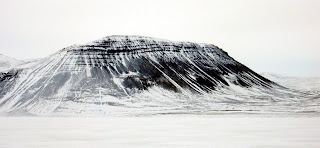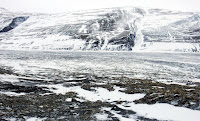The
area I chose to revisit was Strathcona Sound, specifically its eastern end and
the southern valley attached to it. The last time I was there was on April 10, 2017.
(Click on the link to read about my first trip). I was going back one day before the 4th
anniversary. Hard to believe that that
much time has passed. Better late than
never.
I
laid out everything I was taking on the coffee table the day before. Toilet paper, snacks, juice boxes, first aid
kit, Kleenex, matches, earplugs, duct tape, GPS, SPOT, batteries, binoculars,
machete, gun, spare bullets, multitool, spark plugs, Ziploc bags, and spare
gloves & goggles. But wait, there’s
more! I would also be wearing many
layers of clothing to protect me against the cold. The weather can suddenly turn when you least
expect it, so it’s best to be prepared.
Having everything out and ready the day before saved me a lot of time on
the day of the trip.
I
woke up on the morning of April 9 to the sight of overcast clouds. The forecast predicted this would last the
entire day, but I decided to proceed with the trip. I spent an hour putting everything in my
backpack and getting the skidoo ready. I
printed a map of my route and wrote a brief message stating my estimated return
time. I left both papers on the coffee
table. I also informed two coworkers of
where I was going.
I
left at 10:30am, following the road to Victor Bay. I stopped at the top of the first hill and
turned on my GPS & SPOT. I drove off
the road, followed a skidoo trail for some time, and then continued down a side
road towards the cabins on the left side of the bay. Driving onto the ice, I immediately noticed a
plowed ice road heading north along the left side. I replaced my goggles because they were
fogging. I found this strange because I
was wearing a helmet that covered my nose & mouth. I followed the road, enjoying smooth speeds
of 96km/h. The road came to an end just
before the Grade 1 teacher’s cabin at the top of the bay. Little did I know how important this road
would be later in the day.
I
drove off the ice road through an opening in the snowbank. It didn’t take long for me to stop again
because my vision was getting obscured by fog.
I wiped the interior of the goggles with Kleenex, thinking this would
help. No such luck. Frustrated, I removed them and placed them on
the left handle bar. I continued driving
across the bay, my eyes exposed to the Arctic air. Maybe this is how Inuit strengthen their eyes
& vision? I originally wanted to
continue driving north beyond the bay and then turn towards Strathcona Sound,
but changed my mind. I drove carefully,
avoiding large snow drifts. Tipping over
is not fun, especially when the right panel has been removed, because the
exhaust & battery can be seriously damaged.
(The side panels are often removed so that the engine can be
continuously cooled by the Arctic air. I
usually just remove the right panel).
I successfully made it across, passed Graveyard Point, and continued into Strathcona Sound. There was no one else around me. I followed a previously made trail until it made a u-turn. I was now making my own trail. This wasn’t a concern because I’ve previously travelled this way on several occasions. Driving with my eyes exposed was not as bad as I thought it would be. I did, however, have to squint.
It took 30 minutes to arrive at the Nanisivik Naval Facility (NNF). The base is not operational but it looks nearly complete. The most noticeable addition is a tall crane by the dock. I’m guessing it’ll be used to hoist & hold the fuel pipe while it’s connected to the ship needing refueling. The primary purpose of the NNF is to refuel the Harry DeWolf class of Arctic offshore patrol vessels, but I bet other large vessels will use the facility.
I
stretched my legs and took several pictures of the facility.
The snow & ice usually smooths out past Nanisivik, but this year, I had to travel further to reach the smooth ice. I found myself travelling near the centre of the sound. I stopped a few times to photograph the same mountains I saw in 2017. It’s hard not to because they’re majestic. There were still clouds in the sky. I was hoping they would open up by now, but they didn’t.
I passed the entrance to the hidden valley I explored in May 2017. I thought I should also revisit that area later this year.
 |
| Maybe I'll revisit that valley next time. |
I reached the end of Strathcona Sound and headed south. I drove off the ice and continued on solid ground. The landscape looked the same, but there was less snow. I followed the snow and avoided the rocks. I maybe got halfway when I realized the end of the valley was unreachable. I could have driven over rocks but I risked (seriously) damaging the skis & track. I didn’t want to become stranded out here because I was 74km away from Arctic Bay. Time for Plan B.
I parked my skidoo in the middle of a large patch of white snow, next to a small pass I ignored in 2017. The time was 1:00pm. Silence invaded my ears after I turned off the engine, but there was a faint breeze. I replaced my helmet with a toque and refilled the skidoo with gas. Once that was out of the way, I slowly began hiking to the pass. I carried my backpack and firearm.
There were a lot of rocks leading up to the pass. I hiked for 20 minutes before stopping near a hill on the right side. I had no intention of hiking up the jagged mountains because it would take too long. I photographed the mountains, my skidoo in the distance, and the valley itself. From where I stood, I could see many snow paths criss-crossing the ground. Maybe I could have made it to the southern end if I had followed another path? Maybe next time.
I rested, ate some snacks, and looked at the landscape. I wasn’t bothered by the lack of sound; it just made my situation all the more real & calmer. People down south go to their cottages to escape the cities; me, I just drive somewhere out on the land.
I
found a large flat rock to set my camera down and take some timed photographs. There was a lot of running because I only had
10 seconds to get into position. I
followed the trial & error method.
To Be Continued . . .













No comments:
Post a Comment